Raki / Tsikoudia
Cretan raki: The Cretan Spirit
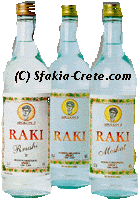
Every autumn after grape harvest, various wine festivities begin throughout Greece. A few days later, in Thessaly, Epirus, Macedonia and on the island of Crete the "Celebration of Tsipouro" takes place.
Tsipouro is a strong distilled spirit containing approximately 37 per cent alcohol per volume and is produced from the must-residue of the wine-press. The name tsipouro is used throughout the country, except for Crete, where the same spirit with a stronger aroma is known as tsikoudia. Also the Oriental name raki is used, from which the term "rakizio" is derived, used to refer to the drink's distillation process, which usually turns into a huge celebration among family, friends and neighbours.
Turkish raki, its traditional drink, is not the same drink as the Cretan one. In Turkey raki was first produced from the residue of grapes left over from wine making only. When a shortage of residue started, spirits from abroad were imported and processed with aniseed.
In the near and middle east countries the drink is known by different names such as Araka, Araki, Ariki which obviously come from the same origin. Some claim that it is called Iraqi (from Iraq) because it was first made in this country and spread to other regions. Others say it got its name from the razaki grapes used in producing it. Both theories are acceptable. Another theory is that arak in Arabic means "sweat" and araki "that which makes one sweat." If one drinks too much raki one does sweat sometimes and when raki is being distilled it falls drop by drop like sweat, so the name could have come from Arabic.
During the Turkish occupation of Crete the name raki was given to the local tsikoudia, since there were some similarities. Now both names are used in Crete equally. The Turkish raki has a history going back 300 years. But it all started much longer ago: famous coppersmiths from Armenia and the Pont, who made nice decorated distilling vessels, confirmed the deep knowledge of distillation in all the Byzantine empire.
History even goes further back. The dietary habits of the ancient Minoans and the Myceneans were apparently in conflict with the contemporary Mediterranean diet, according to research conducted by scientists from Greece, Britain, Italy and the United States. Examination of organic residue on ancient pottery shows that the Minoan and Mycenean diet was mainly based on meats and greens, while fish was on the bottom of their culinary preferences. In addition, tsikoudia was a favourite drink with their meals.
Just a few years ago, the admirable actions of some people helped in fortifying ouzo, tsipouro, tsikoudia and the distillation of Corinthian currant as exclusive Greek products. The European Union protects the following unique spirits as being only original when coming from its original place: Cognac, Brandy de Jerez, Grappa di Barolo, Berliner Kümmel, Genièvre Flandres Artois, Scotch Whisky, Irish Whiskey, Tsikoudia from Crete.

The names of tsipouro, tsikoudia and ouzo are and have been mixed up often. Ouzo is being produced traditionally and exclusively in Greece. It belongs to the "anise" category and has an aniseed flavour (aniseed is what gives ouzo its trademark milky countenance when water is added). The indigenous mastic (masticha) of Chios island, ginger, cinnamon and other aromatic seeds, plants and fruits are all part of the distillation process, and give ouzo its distinctive taste. Its main distinction from other similar drinks lies with the traditional method of its flavouring.
The 1959 edition of "The Times of Thessaly" provides an interesting anecdote of how ouzo got its name. "During a visit to Thessaly in 1896, the late professor Alexander Filadelfefs delivered to us valuable information on the origins of the word "ouzo", which has come to replace the word "tsipouro". According to the professor, tsipouro gradually became ouzo after the following event: Thessaly exported fine cocoons to Marseilles during the 19th century, and in order to distinguish the product, outgoing crates would be stamped with the words "uso Massalia" - Italian for 'to be used by Marseilles'. One day, the Turkish consulate physician, named Anastas Bey, happened to be visiting the town of Tyrnavos and was asked to sample the local tsipouro. Upon tasting the drink, the physician immediately exclaimed: 'This is uso Massalia, my friends' - refering to its high quality. The term subsequently spread by word of mouth, until tsipouro gradually became known as ouzo.
Tsikoudia is known as zivania in Cyprus and souma in the Cycladic islands.
As with many gastronomic delicacies, most alcoholic beverages have their roots in poverty. Tsipouro and tsikoudia are produced in poor viniculture soil. Therefore, every year after the vines are pruned, the vineyard provides wood for the fireplace, grape leaves for cooking (the famous Greek "dolmades"), grapes as a fruit or as a pastry and, of course, wine. Some of the grape must is used to make molasses, which when combined with flour become must-jelly, must-rolls as well as other well-known Greek pastries. When must is made from grapes, the seeds, stems and grape-peels aren't thrown away, rather they are distilled to produce tsipouro and tsikoudia, spirits consumed for centuries in this part of the Mediterranean.
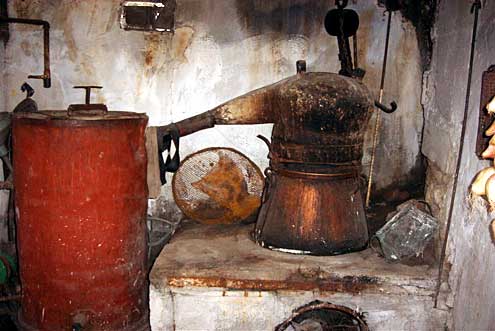
© Jarmila Peskova Skranakova - Raki is made here, Lassithi
Grape-gathering, wine-making and tsikoudia-making are activities enjoyed in the autumn every year, from October to mid December. Wine-making involves crushing the grapes in special stone constructions called "patitiria", or wine presses. This can be done by feet or with a small machinery. The remains in the patitiria, stemfila or must, after most of the grape juice has been removed, is allowed to ferment and then is distilled. Traditional distilleries (called a rakokazano, raki boiler, or kazani, plural), are comprised of large copper boilers and include long copper funnels on top so that the steam can escape. The distillers themselves are called 'kazanari'. The funnels, which pass through barrels placed on the sides of the distillation flask and are filled with cold water, end up on the outside of the barrels, on top of empty glass containers. Herbage is first placed on the bottom of the boilers which are then filled with stemfila and a little water or wine, hermetically sealed and finally placed onto the bonfires.
Images courtesy of © Willem Hurkmans 2014
The hot steam passes into the funnel and as it then travels through the barrel of cold water, it condenses and liquidates. In approximately a half an hour, the warm raki or tsikoudia begins to fall drop by drop, on the other side of the funnel, into the glass containers. The liquid that first comes out of the funnel cannot be consumed but is used for pharmaceutical purposes. However, on Crete some people do drink it!
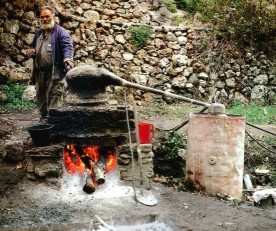
The final amount of distilled liquid contains the least amount of alcohol, whereas the actual tsikoudia is produced during the middle of the entire process. This lasts for about three hours, during which the owners of the boilers must taste for alcohol content, increase or decrease the heat and finally stop distillation when the tsikoudia has acquired the desired taste. In Crete a Baumé hydrometer is used to determine the percentage of alcohol. It is a calibrated glass tube that as a float goes into the liquid. From a scale the percentage of alcohol can be determined. The raki is fine at 17 degrees Baumé (40% alc.), or sometimes 18 degrees Baumé (43% alc.).
Tsikoudia, according to the legislation in force, must have 37,5% alcohol and its maximum methanol concentration should not be more than 8 gr. per litre

Baumé hydrometer
For the production of the tsikoudia two to three destillation processes are taking place in copper caldrons. This way the distillate is protected from the smelly substances of boiling and at the same time its sensitive aroma is preserved.
The entire process becomes a celebration in which friends and relatives take part by bringing food and sampling the drink as it is being made. Each step in the distillation process has a particular ritual and the presence of friends is a must.
In some places of Crete people make a variety of tsikoudia, called mournoraki. This is coloured red and is distilled from mulberries. It is quite rare and even more strong then tsikoudia. I had it offered twice in the village of Anopoli, Sfakia region.
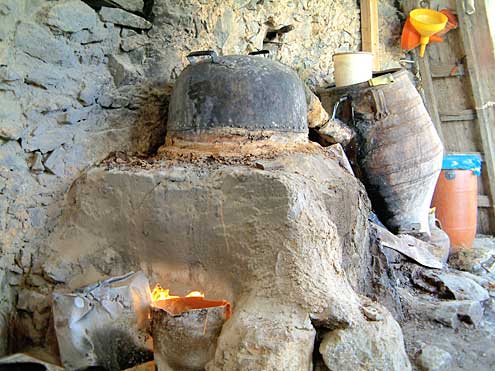
Raki distillery Kallikratis - © Wiltrud Klundt Oct. 2003
All wine producing areas in Crete have their traditional kazani, raki production units. There are also several modern distilleries.
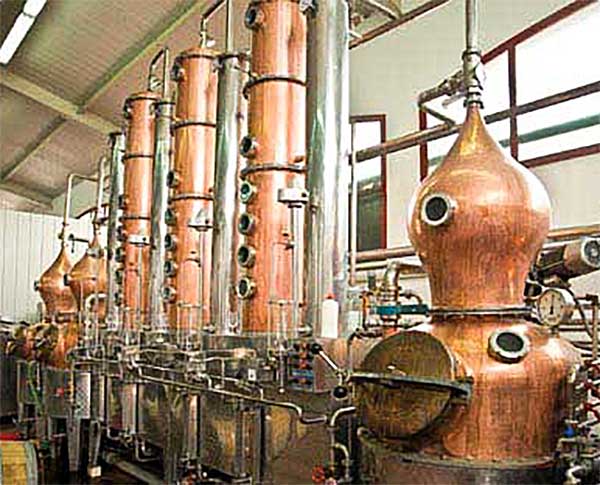
Some tips about drinking tsikoudia:
As a tourist coming to Crete there is a 100% chance that more sooner than later you will get offered at least 1 glass of tsikoudia. For new visitors this happens usually after your first dinner in a restaurant or taverna. My experience is: the more touristic the place is you visit, the more horrible is the raki. Horrible raki is cheap, very good raki inexpensive. If you are a local you usually get raki from friends or family, from their own produce. Most Cretan families like this have several bottles, jerry cans or even barrels with raki of different origin and taste. Only if you are a friend of the family and/ or are invited in a private house you have the chance to taste this. And there's where you can start to like it.
Luckily there are also very nice public places where they serve good raki. Like with most spirits, but this applies certainly to raki, never drink it on an empty stomach. Have it after your meal or have it accompanied by small snacks. If you are not used to spirits or have a weak stomach: drink water after each sip. Never mix raki with another drink. Once you start to drink raki, leave it with raki that time, so do not change to wine or beer after. This will make you very drunk and experience a severe hangover after.
A few glasses of raki can make your head very clear, an effect which to my opinion is unique to it. After you get to sleep it may happen you have special 'raki dreams', which can be more vivid than life: it feels like you are awake and very special things happen to you.
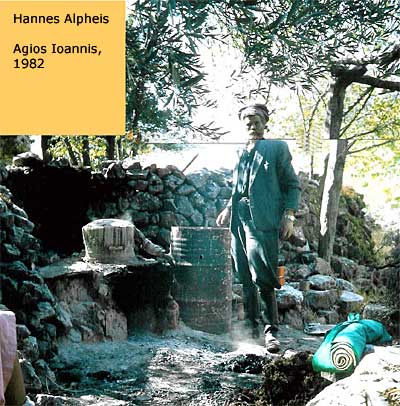
If you do not like to drink an offered raki: do not drink it and leave the glass full. An empty glass is a sign to your hosts that you liked it and they happily will fill it again. However, after the forth glass you will not mind anymore and may start to like it, eventually start to love it!
When that happens, as a foreign guest, you might have a problem: it's practically impossible to buy raki outside Crete. And if you find it anyway it is bottled raki, maybe from a factory, and this will most likely taste like a factory and not like good raki.
So you might get interested in buying some on the spot, for the long and cold winter. For this: wait until the last day of your stay. If you have been a guest for some time in 1 place (a week or longer) it can happen that your host will give you a bottle for present! If not, and if you like his raki, you can ask if it is possible to buy some from him. It will depend on his stock and his mood if this is possible. Please note that you're not in a shop! It can happen that he just has a private stock of some liters, given by his family. It can also happen he has enough and bought it from a personally selected still. In huge quantities a normal price for him would be Euro 3 to the kilo (raki is measured in Crete in kilos, not in litres). A fair price for you would be at least Euro 5.
If possible, carry your raki back home in a plastic container, like an empty table water bottle (0,75 or 1,5 litres) or a more endurable plastic Cola bottle. You are no longer allowed to keep this in your hand luggage if you travel by plane, due to the new hand luggage safety regulations since 2006.
For those of you who do not have enough with 1 bottle: as long as you live in the European Community it is now allowed by customs to take back home 10 kilos of raki per person as a maximum (or 40 litres of wine or 120 litres of beer...) free of charge. If you plan to take this maximum: in many Cretan shops there are plastic jerrycans available. Very handy are the 12 litres ones (about Euro 4) and more convenient are the 5 litres ones (Euro 3).
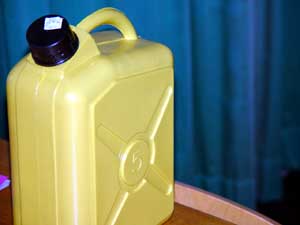
It can happen that you wake up with a serious hangover. But normally raki will only give you one because you really had too much of it, since it is very clean. If you happen to have a terrible one: a Cretan might advise you to 'take the hair of the dog (that bit you)', meaning to have 1 raki before breakfast... It's up to you, but I've heard it helps.
Furthermore, raki is claimed to be a medicine for many ordinary diseases, like a cold or a headache or diarrea.
And to conclude: if you stay in a nice place and are in for a crazy night: invite the table with locals next to you for a round of raki. In non-touristic places in Crete a glass of raki is about 1 Euro.
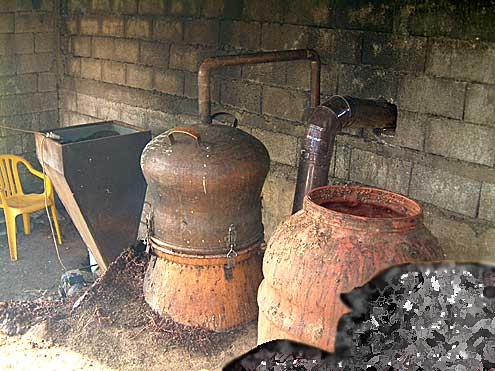
Raki distillery Kallikratis - © Wiltrud Klundt Oct. 2003
More information about raki from Sfakia and Crete is available at our Cretan food and drinks forum:
Cretan food and drinks forum







